- Joined
- Jan 10, 2010
- Messages
- 2,750
- Reaction score
- 3,854
I agree with you on the whole but they seem convinced that some orthopods/cards guys who don't operate that much can make a big chunk of change by doing reads. He also complained about private practices being sweatshops with massive requirements for reads and said that cutting spots would only make this problem worse. There's also the question of radiologist assistants. Again, I don't agree with this. I'm just conveying what they seemed to passionately believe.
They are right to a certain extent in that some specialties (most notably cardiology) encroach on imaging turf by reading echos, diagnostic caths, and cardiac MRIs. Sure this problem could be exacerbated if there was a huge shortage of radiologists to read the studies. However that is simply not the case right now, and continuing to saturate the market to prevent future turf wars seems like a poor strategy that happens to benefit those at the top who run large imaging companies or use resident services.


